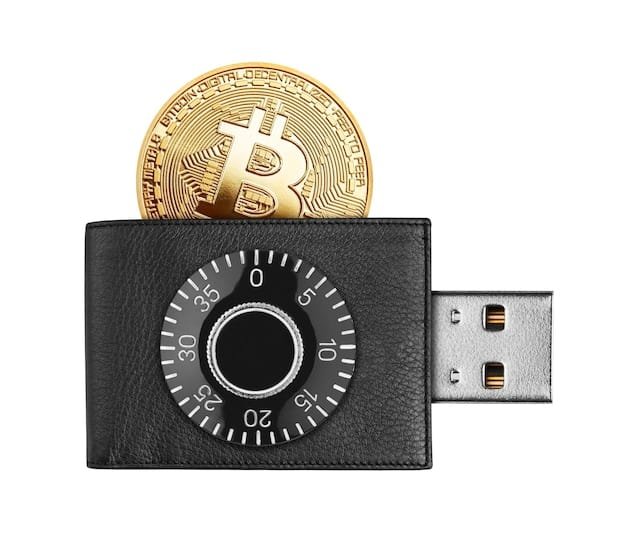Crypto Cold Storage vs. Hot Wallets: Choosing the Right Security

Crypto cold storage offers offline security, ideal for large, infrequent transactions, while hot wallets provide convenient online access, better suited for smaller, frequent trading; understanding their differences is critical for securing your cryptocurrency assets effectively.
Navigating the world of cryptocurrency security can feel like traversing a minefield. With digital assets constantly under threat from hackers, it’s crucial to understand the different methods available to protect your investments. This article delves into the critical comparison of crypto cold storage vs. hot wallets: which is right for your security needs?, offering insights into each method’s pros, cons, and suitability for various user profiles.
Understanding Crypto Wallets: Hot vs. Cold
The first step in securing your cryptocurrency is understanding the tools at your disposal. Crypto wallets, at their core, are software or hardware solutions that allow you to store, manage, and transact cryptocurrencies. However, not all wallets are created equal, and the distinction between hot and cold wallets is paramount for your security strategy.
Hot wallets are digital wallets that are connected to the internet. This constant connectivity allows for quick and easy transactions, making them ideal for active traders or users who frequently use their cryptocurrency. Cold wallets, on the other hand, are not connected to the internet, drastically reducing the risk of online attacks. The choice between them depends on your individual security needs and usage patterns.
Key Differences in Connectivity
The fundamental difference lies in their connectivity. Hot wallets are always online, while cold wallets remain offline unless needed for a transaction. This difference significantly impacts their security profiles.
Accessibility vs. Security
Hot wallets offer unparalleled accessibility, allowing you to manage your funds from anywhere with an internet connection. Cold wallets prioritize security over convenience, requiring more steps to access and transact with your cryptocurrency.

- Hot Wallets: Convenient for daily transactions but more vulnerable to online threats.
- Cold Wallets: Secure for long-term storage but less convenient for frequent use.
- Consider Your Needs: Choose based on how often you plan to access and use your cryptocurrency.
In conclusion, understanding the distinction between hot and cold wallets is crucial for making informed decisions about your cryptocurrency security. Consider your individual needs and risk tolerance when choosing the right wallet for you.
Hot Wallets: Convenience at a Cost?
Hot wallets are the go-to choice for many cryptocurrency users due to their convenience and ease of use. These wallets are typically software-based and can be accessed via desktop, mobile, or web browser. Their always-online nature allows for quick and seamless transactions, making them ideal for active trading and everyday use.
However, this convenience comes with a trade-off: increased vulnerability to online threats. Because hot wallets are constantly connected to the internet, they are more susceptible to hacking attempts, malware, and phishing scams. It’s essential to understand these risks and take precautions to mitigate them.
Types of Hot Wallets
There are several types of hot wallets available, each with its own set of features and security considerations. Exchange wallets, desktop wallets, mobile wallets, and web wallets each offer different balances of convenience and security.
Security Risks of Hot Wallets
The primary risk associated with hot wallets is their online nature. This makes them a target for hackers who seek to steal cryptocurrency. Phishing attacks, malware, and exchange hacks are common threats.
- Exchange Wallets: Convenient for trading but control of the private keys rests with the exchange.
- Desktop & Mobile Wallets: Offer more control but require responsible security practices from the user.
- Web Wallets: Easiest to use but often the least secure, relying on the provider’s security measures.
In summary, hot wallets provide convenience and accessibility but demand a heightened awareness of security risks. Choose a reputable provider, enable two-factor authentication, and be vigilant against phishing attacks to protect your funds.
Cold Storage: The Fortress for Your Crypto
Cold storage provides an enhanced security solution to safeguard your cryptocurrency. Unlike hot wallets, cold storage solutions operate offline, creating a ‘air gap’ that drastically diminishes the risk of online compromise. This technique is especially desirable for individuals holding significant cryptocurrency assets or those planning for long-term investment strategies.
By eliminating the online connection, cold storage significantly reduces the attack surface available to hackers and malicious entities. This offline nature provides peace of mind, knowing that your digital assets are shielded from unauthorized access and theft.
Hardware Wallets: A Popular Choice
Hardware wallets like Ledger and Trezor are specifically designed to store your private keys offline. They’re immune to computer viruses that could steal data from a software wallet.
Paper Wallets: A Simple Alternative
Paper wallets involve printing out your public and private keys on a piece of paper. While they’re free and easy to create, they require meticulous handling and storage to prevent damage or loss.

- Enhanced Security: Offline storage protects against online hacking and malware.
- Long-Term Storage: Ideal for hodling and large cryptocurrency holdings.
- Reduced Risk: Minimizes exposure to cyber threats and unauthorized access.
In conclusion, cold storage provides robust protection for cryptocurrency by keeping private keys offline, and defending against cyber threats. It is an essential component of any comprehensive cryptocurrency security strategy, offering confidence and defense for the long-term well-being of your digital investments.
Weighing the Pros and Cons: A Detailed Comparison
Choosing between crypto cold storage vs. hot wallets demands a careful assessment of their respective advantages and disadvantages. Both options offer distinct benefits and drawbacks that cater to different user needs and security preferences. A comprehensive comparison helps you determine which strategy aligns best with your requirements.
A detailed breakdown of the pros and cons of each approach enables you to weigh critical factors such as convenience, security, cost, and ease of use. By understanding these nuances, you can make an informed decision that maximizes the security and accessibility of your cryptocurrency assets.
Hot Wallets: Advantages and Disadvantages
Hot wallets offer seamless accessibility and convenience for frequent transactions. However, their online nature makes them more susceptible to hacking and online threats.
Cold Storage: Advantages and Disadvantages
Cold storage fortifies security through offline storage, protecting against cyber threats and unauthorized access. The trade-off is reduced accessibility and convenience for daily use.
- Hot Wallets: Pros include convenience and ease of use. Cons include heightened vulnerability to online attacks.
- Cold Storage: Pros include enhanced security and protection against cyber threats. Cons include reduced accessibility and potential inconvenience.
In summary, evaluating the pros and cons of hot wallets and cold storage enables you to align your choice with your specific requirements. Prioritize security for long-term holdings and opt for convenience when frequent transactions are necessary.
Best Practices for Securing Your Crypto, Regardless of Choice
Regardless of whether you choose a hot wallet, cold storage, or a combination of both, adhering to security best practices is crucial for protecting your cryptocurrency. These practices are not limited to the type of wallet you use but encompass various measures that enhance your overall security posture.
Implementing strong passwords, enabling two-factor authentication, keeping your software up to date, and exercising caution when interacting with online resources are fundamental steps to mitigating risks. These practices ensure that your digital assets remain as secure as possible.
Strengthening Your Password Security
Use a complex and unique password for each of your accounts and cryptocurrency wallets. Avoid using personal information or easily guessable words in your passwords.
Enabling Two-Factor Authentication (2FA)
Enable 2FA on all your cryptocurrency accounts and wallets. 2FA adds an extra layer of security by requiring a second verification method, such as a code sent to your mobile device.
- Strong Passwords: Use complex, unique passwords and avoid personal information.
- Two-Factor Authentication: Enable 2FA for added security against unauthorized access.
- Software Updates: Keep your software and operating systems up to date to patch security vulnerabilities.
In essence, following security best practices significantly enhances the protection of your cryptocurrency, regardless of your wallet choice. These practices minimize the risk of unauthorized access, cyber attacks, and other threats, ensuring the long-term security of your digital assets.
Combining Hot and Cold Wallets: A Balanced Approach
A balanced method is to combine **crypto cold storage vs. hot wallets** for your cryptocurrency security, leveraging the respective advantages of each option. This entails using a hot wallet for small sums and daily transactions while keeping the majority of your holdings in cold storage for optimum security.
This strategy enables you to enjoy the ease of use of a hot wallet without sacrificing the robust protection offered by cold storage. By carefully distributing your assets, you can strike a balance between accessibility and security that suits your specific needs.
Diversifying Your Wallet Strategy
Diversify your cryptocurrency security by allocating your holdings. Keep small amounts in a hot wallet for daily transactions and large amounts in cold storage for added defense.
Regularly Transferring Funds
Periodically transfer funds from your hot wallet to your cold storage to minimize the potential loss from a security breach. Regularly evaluate your risk exposure and adjust your allocation as necessary.
- Small Amounts in Hot Wallet: Use for daily transactions, reducing exposure in case of compromise.
- Large Amounts in Cold Storage: Keeps the bulk of your holdings secure from online attacks.
- Regular Transfers: Periodically move funds from hot to cold wallet to minimize risk.
In conclusion, a balanced strategy of using both hot and cold wallets enables you to attain an effective balance between convenience and security. By carefully allocating and managing your cryptocurrency holdings, you may improve the overall security and peace of mind.
| Key Point | Brief Description |
|---|---|
| 🔒 Cold Storage | Offline storage, superior security for large holdings. |
| 📱 Hot Wallets | Online wallets, convenient for daily transactions. |
| 🛡️ Security Practices | Use strong passwords and enable 2FA for extra protection. |
| ⚖️ Balanced Approach | Combine hot and cold wallets for optimal security and accessibility. |
FAQ
▼
Hot wallets are connected to the internet, offering convenience for transactions but increasing vulnerability to cyber threats. Cold wallets, on the other hand, are offline, providing greater security for long-term storage.
▼
A hardware wallet is considered a form of cold storage. While it may connect to a computer for transactions, the private keys remain securely stored offline within the device, protecting them from internet-based threats.
▼
Keeping crypto on an exchange carries risks, including potential hacking, security breaches, and the possibility of the exchange freezing or losing funds. You do not have full control over your private keys.
▼
Protect your hot wallet by using a strong, unique password, enabling two-factor authentication (2FA), keeping your software up to date, and being cautious of phishing attempts and suspicious links.
▼
You should use cold storage for long-term holdings, large amounts of cryptocurrency, or when you prioritize security over frequent access. It’s ideal for assets you don’t need to trade or spend regularly.
Conclusion
In conclusion, the choice between crypto cold storage vs. hot wallets depends on your individual needs, risk tolerance, and usage patterns. Hot wallets offer convenience for daily transactions, while cold storage provides enhanced security for long-term holdings. A balanced approach, combining both methods and adhering to security best practices, can provide the optimal solution for securing your cryptocurrency assets.





